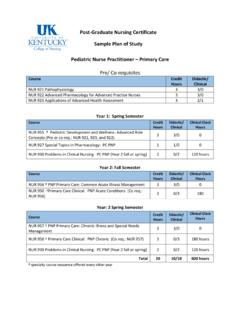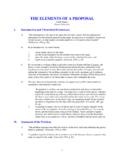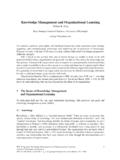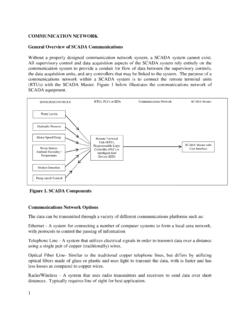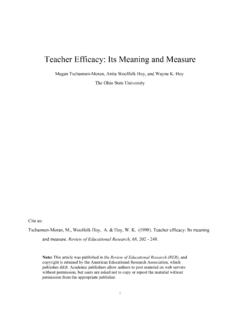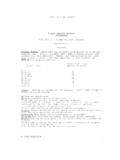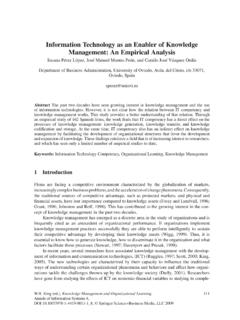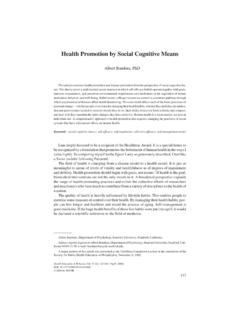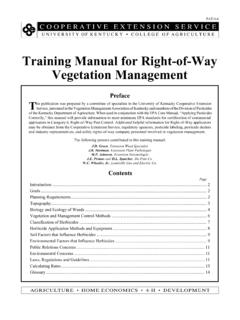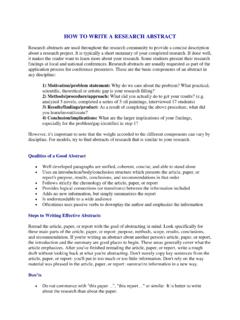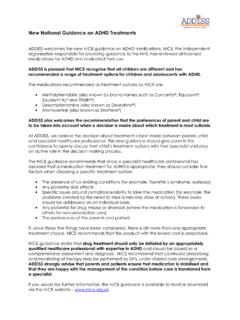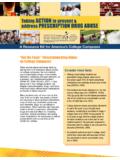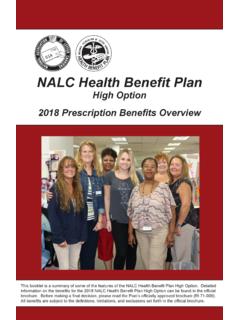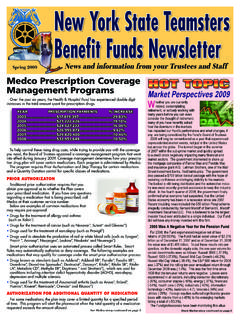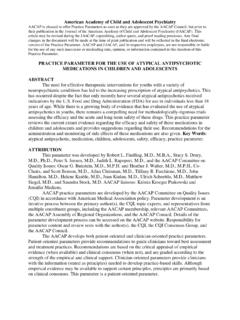Transcription of Adderall is Definitely Not a Drug : Justifications for the ...
1 Substance Use & Misuse, 45:31 46 Copyright 2010 Informa Healthcare USA, : 1082-6084 (print); 1532-2491 (online)DOI: Stimulant Misuse: Justifications Adderall is Definitely Not a Drug : Justificationsfor the Illegal Use of adhd StimulantsALAN D. DeSANTIS1 AND AUDREY CURTIS HANE21 Department of Communication, University of Kentucky, Lexington,Kentucky, USA2 Department of Communication, Newman University, Wichita, Kansas, USAIn-depth interviews were conducted in 2007 with 175 undergraduate students (94 males,81 females, 13 non-Caucasian) at a large, public southeastern research universitylocated in an urban area in the United States. Our primary goal was to identify how thesestudents conceive of Attention Deficit Hyperactivity Disorder ( adhd ) stimulants andtheir illegal use. We discovered that these students frame stimulant use as both physicallyharmless and morally acceptable.
2 Specifically, these students justify their drug usethrough the use of four recurring prostimulant arguments: 1) comparison-and-contrast,2) all-things-in-moderation, 3) self-medicating, and 4) minimization arguments. Wediscuss limitations to the study and conclude by suggesting five strategies for preventionresearchers that would directly target these four ; Adderall ; drug abuse; college studentsIntroductionAttention Deficit Hyperactivity Disorder ( adhd ) was originally believed to be primarilya pediatric condition (McCabe, Teter, and Boyd, 2004; Olfson, Marcus, Druss, and Pincus,2002; Robinson, Sclar, Skaer, and Galin, 1999; Rushton and Whitmire, 2001; Safer, Zito,and Fine, 1996).1 Recent data suggests, however, that 30% 70% of children with adhd continue to have symptoms in adulthood (Cantwell, 1985; Mannuzza et al., 1991; Vollmer,1998; Wender, 1995).
3 This population is increasingly seeking treatment. The number ofAddress correspondence to Audrey Curtis Hane, , Director of the School of Artsand Humanities, Newman University, 3100 McCormick Ave., Wichita, KS 67213. rise in the diagnosis and treatment of American children with adhd has been welldocumented since the mid-1990s (McCabe et al., 2004; Olfson et al., 2002; Robinson et al., 1999;Rushton and Whitmire, 2001; Safer et al., 1996). According to the Centers for Disease Control (2005),there are over million children between the ages of 4 and 17, or a national prevalence rate of ,that have been diagnosed with adhd . Of these, million children have been prescribed stimulantsto treat the Use Misuse Downloaded from by Young Library For personal use and HaneAmerican adults who are prescribed medication to treat the disorder has increased by 90%from 2002 to 2005, with adults receiving one third of all prescriptions (Okie, 2006).
4 Adderall (mixed salts amphetamine) is the most widely prescribed medicine for chil-dren and adults with adhd , with Ritalin (Methylphenidate) and Dexedrine (dextroam-phetamine) also being considered first-line pharmacotherapy. Because of the potential forabuse and psychological and physical dependency, the Drug Enforcement Adminis-tration (DEA) classifies these stimulants as Schedule II substances (Woodworth, 2000).Consequently, Adderall , Ritalin, and Dexedrine are legally available only through prescrip-tion, with a limit of 30 days worth of doses, and no refills. Additionally, Schedule II drugsare subject to production quotas set by the these Schedule II restrictions, the illegal use of adhd stimulants has becomeincreasingly popular during the late 1990s on American college campuses (Babcock andByrne, 2000; Hall, Irwin, Bowman, Frakenberger, and Jewett, 2005; Low and Gendaszek,2002; McCabe, Knight, Teter, and Weschsler, 2005; McCabe, Teter, and Boyd, 2006;Shillington, Reed, Lange, Clapp, and Henry, 2006; Teter, McCabe, Cranford, Boyd, andGuthrie, 2005; Teter, McCabe, LaGrange, Cranford, and Boyd, 2006; White, Becker-Blease, and Grace-Bishop, 2006).
5 Specifically, Babcock and Byrne found that 16% of the283 students sampled used Ritalin recreationally. Hall et al. (2005) reported that 17% ofthe 179 males and 11% of the 202 females surveyed illicitly used stimulant number was more than doubled in Low and Gendaszek s investigation of a smallNew England college with of the 150 students sampled reporting illicit use of the scope to multiple sites, McCabe et al. (2005) surveyed 10,904 studentsat 119 nationally representative 4-years colleges in the United States. They found that the students surveyed had used an illegal prescription stimulant in their life, with in the past year. Furthermore, they reported that illicit use was highest among 1)white fraternity members; 2) students from the northeastern region of the United States;3) students from colleges with more competitive admission standards.
6 They also foundthat nonmedical prescription stimulant users were more likely to report use of alcohol,cigarettes, marijuana, ecstasy, cocaine, and other risky behaviors (p. 96).3Of particular interest to this current line of investigation is DeSantis, Webb, and Noar s(2008) survey research of 1,811 students at a large public institution in the American SouthEast. They discovered that while only 4% of their participants reported having a prescriptionfor an adhd medication, 34% claimed to have used adhd medication often-discussed Schedule II drugs include cocaine (used as a topical anesthetic), Mor-phine, Phencyclidine (PCP), short-acting barbiturates, injectable methamphetamine, and most pureopioid agonists such as opium and OxyContin, (USDOJ DEA).3 Exploring the issues of ethnicity and motivation, Teter, McCabe, LaGrange, Cranford, andBoyd (2006) asserted that Caucasians and Hispanics were more likely to illegally use prescriptionstimulants than African Americans and Asians.
7 They also found that the majority of students who usedillegal prescription stimulants, regardless of ethnicity, did so to enhance their academic percent reported using to aid concentration, to help study, and to increasealertness (p. 1501). Other motives not associated with academic performance included getting high( ) and experimentation ( ), (p. 1501).4Of these 574 illegal users, 49% (n=260) were males, 51% (n=273) were females. Forty-oneparticipants did not report a sex. Whites comprised 94% (n=536) of illegal users; the remaining 6%of the participants consisted of 14 African Americans, 4 Asian/Pacific Islanders, 5 Hispanic/Latinos,and 10 other or mixed raced. Five participants reported no ethnic affiliation. Of the illegal users, 22%(n=112) were freshman, 25% (n=123) were sophomores, 28% (n=140), and 25% (n=128)were seniors.
8 Seventy-one of our reported users did not report a class rank. Finally, 27% (n=155)of these illegal users were in fraternities, while 31% (n=178) were members of a Use Misuse Downloaded from by Young Library For personal use for the Illegal Use of adhd Stimulants33 When the students in DeSantis et al. s (2008) study were asked whether their use ofthese Schedule II amphetamines posed a health risk, only 2% thought they were verydangerous. Eighty-one percent thought that the illicit use of adhd medication was either not dangerous at all or only slightly dangerous. Additionally, many of these samestudents had little or no moral apprehension about the illegal acquisition or use of was the disturbing nature of these later two findings that engendered this currentline of investigation. For, while DeSantis et al.
9 S (2008) survey data answered some in-triguing questions about illicit stimulant use, it stopped short of supplying a complex andcontextually grounded qualitative description of students views and beliefs about their , we conducted 175 in-depth interviews with participants from DeSantiset al. s (2008) survey cohort for the purpose of understanding student conceptions of illegalADHD stimulant discovered that because of, and aided by, the exceedingly high rate of illegalstimulant use on campus, a popular, socially constructed storyline has been created andinternalized by many of these at-risk students. In general terms, this narrative rhetoricallyframes stimulant use as both physically harmless and morally acceptable and takes the formof four recurring prostimulant arguments. Furthermore, there is strong discursive evidenceto suggest that many of these arguments were not created in isolation by individual students,but have been collectively crafted and shared on a campus where illegal stimulant use isoften discussed as a stigma-free part of the the remainder of this paper, we will 1) discuss the methodology of ourresearch; 2) detail the four recurring Justifications used by our participants; and 3) discusssome implications of our findings with an eye toward health-prevention convenience sample of 175 full-time undergraduates at the university was interviewed,using hand-held audio tape recorders, during Spring and Summer of 2006.
10 Table 1 reportsthe interviewee demographic categories, including gender, race, year in school, and Greekstatus. Along with the primary author of this study, six paid undergraduate students alsoconducted interviews. The undergraduate interviewers had all completed an upper-divisionresearch methods class and were certified by the university s Institutional Review , the interviewers were trained and supervised by the researchers in interview-ing procedures, ethical guidelines, and transcription protocol. Each of the undergraduateinterviewers were given a detailed interviewing script to follow and obtained written con-sent before each interview. The interview script comprised 15 questions. The questionsaddressed four basic issues, including demographics, Adderall usage patterns, ethical/legalimplications, and physical side effects.
